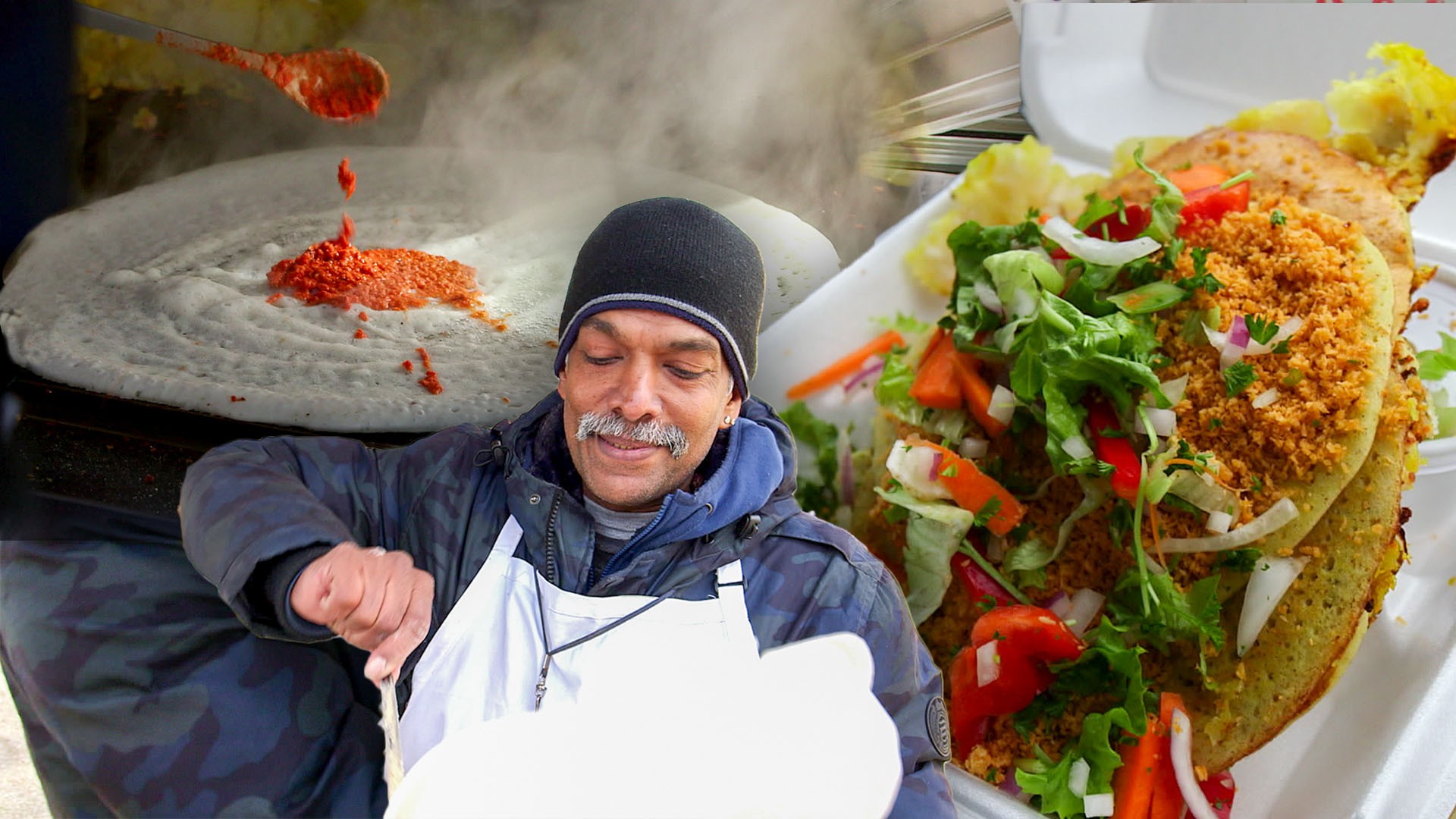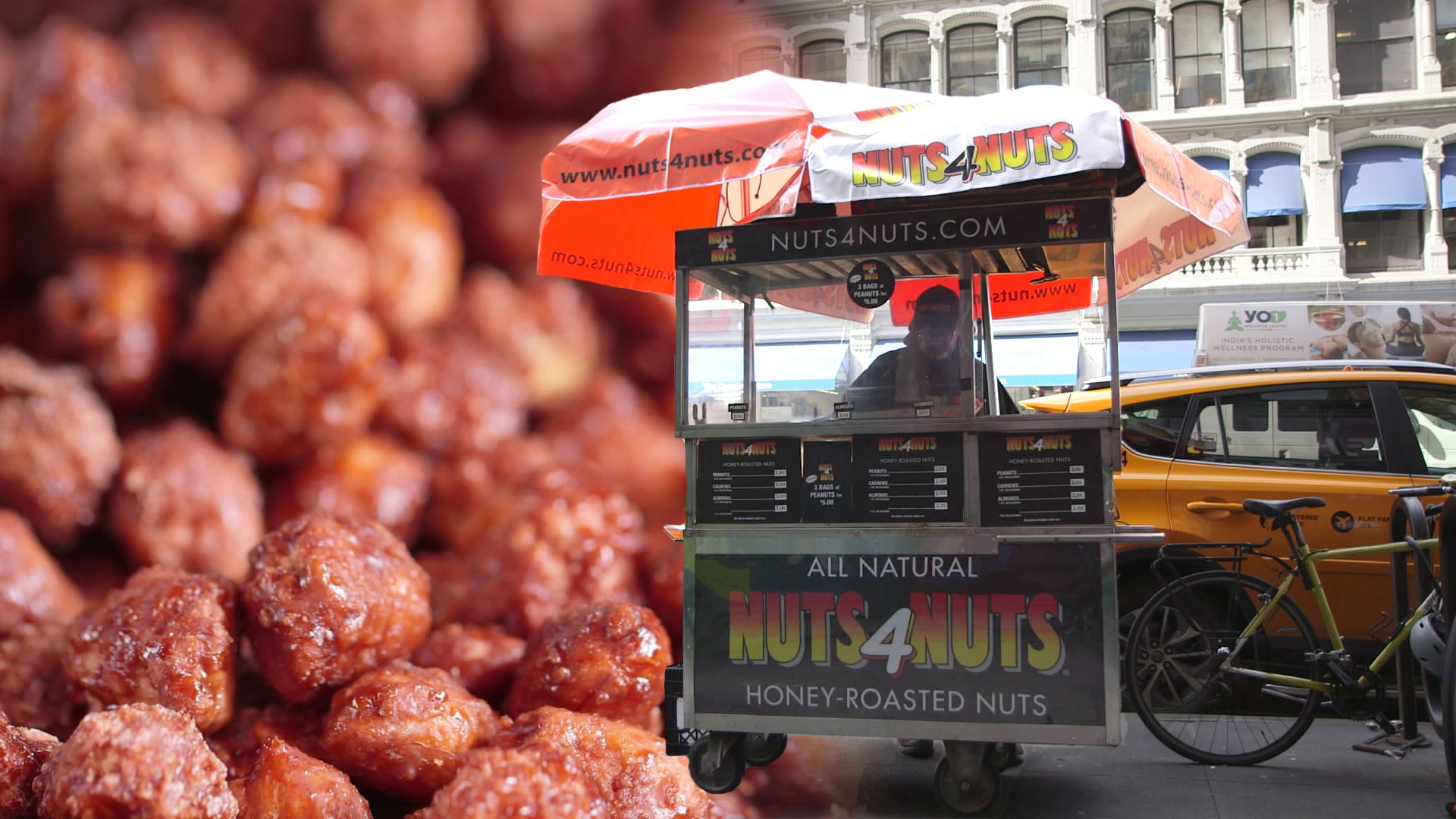When she was 25 years old, Maria* made the journey from Ecuador to the United States. Without friends, family, or more than a few words of English, her first few months in New York were tough. Nevertheless, she settled in Jackson Heights, Queens, where she began selling dishes from her homeland via a modified shopping cart. After five years of dodging the local police and sanitation workers, she was able to cobble together enough money to buy her own food truck, which she has been operating for the last decade under the rumbling tracks of the 7 train.
Advertisement
Mother and daughter grillign Ecuadorian chuzos and corn.
On a sunny Saturday afternoon, I stop by with Sean Basinski, director of the Street Vendor Project, an arm of Urban Justice Center, a local non-profit that provides legal aid and advocacy for marginalized communities. Launched in 2001, the initiative currently has more than 1,800 street food vendor members in New York and hosts events such as the annual Vendy Awards, sometimes nicknamed the Oscars of Street Food.“I’m proud to be from Ecuador,” Maria tells us. “People come here because they know Roosevelt Avenue has a lot of Ecuadorian food that you won’t find anywhere else.” As we speak, she piles aluminum takeaway containers high with chicharrones, morcilla (blood sausage), llapingachos (griddled mashed potato cakes), humitas (freshly ground corn dough steamed in husks), and hornado de chancho, a whole pork shoulder slow-roasted until the skin is shatteringly crisp and the meat surrenders to the gentle tug of a plastic fork. Maria’s 18-year-old daughter helps out by manning a small charcoal grill. Flecks of gray ash gather in her dark hair as she slathers charred ears of corn in Hellman’s mayonnaise and dusts them with queso fresco.All of these dishes take time to prepare and Maria estimates she works 10 hours a day, five days a week. Business is good, but it’s a constant battle for the mother-daughter team to turn much of a profit. Every two years, Maria has to shell out $20,000 on the underground market for a street food vendor’s permit—a hundred times the official legal rate of $200. It’s a struggle to scrape together the cash, but she would rather pay it than risk thousands of dollars in fines or the loss of her truck.
As we speak, she piles aluminum takeaway containers high with chicharrones, morcilla (blood sausage), llapingachos (griddled mashed potato cakes), humitas (freshly ground corn dough steamed in husks), and hornado de chancho, a whole pork shoulder slow-roasted until the skin is shatteringly crisp and the meat surrenders to the gentle tug of a plastic fork. Maria’s 18-year-old daughter helps out by manning a small charcoal grill. Flecks of gray ash gather in her dark hair as she slathers charred ears of corn in Hellman’s mayonnaise and dusts them with queso fresco.All of these dishes take time to prepare and Maria estimates she works 10 hours a day, five days a week. Business is good, but it’s a constant battle for the mother-daughter team to turn much of a profit. Every two years, Maria has to shell out $20,000 on the underground market for a street food vendor’s permit—a hundred times the official legal rate of $200. It’s a struggle to scrape together the cash, but she would rather pay it than risk thousands of dollars in fines or the loss of her truck.

Advertisement
“That huge markup leaves vendors without much opportunity to make further investments in their business,” says Matthew Shapiro, Legal Director of the Street Vendor Project. “Many people buy lunch or coffee from a truck every day without thinking twice about the contributions those vendors are making to this city or the challenges they face.”According to a report by the Institute for Justice, in 2015 New York’s street vendors contributed $293 million to the local economy and generated an estimated $71.2 million in local, state, and federal taxes. That was the same year that the city’s environmental control board doled out a whopping 18,744 vending violation tickets. Current estimates place the number of vendors in New York at around 20,000, yet since 1983, the number of street food vendor permits has remained capped at roughly 4,000. Since the waiting list for permits closed in 2007, most street food vendors are forced to pay exorbitant rates as high as $25,000 on the blackmarket. To make back their investment, many street food vendors cluster in high-traffic areas in Midtown and Lower Manhattan, where they often face police harassment.“Mayor de Blasio claims to be a progressive mayor. He ran on this platform of the tale of two cities, of helping out the most marginalized, and there’s no clearer example of that than street vendors,” Shapiro tells MUNCHIES. “The problem with the underground market was created by the city in the first place and they need to fix it. They need to provide some relief to these people who just want to work.”
Advertisement

Lola sells ice cream and espumillas in the summer months.
On April 11, hundreds of street food vendors crowded onto the steps of City Hall for a rally in support of the proposition. Standing near the front of the protest was Lola, an Ecuadorian woman who sells espumillas, marshmallow-like meringues that she piles onto ice cream cones in pink-and-white swirls. Lola recently paid $6,600 for a six-month summer vending permit. She lives alone and worries about how to support herself during the off months of the year. In order to avoid a paper trail, she says the permit owner demanded she make the payment in two cash installments. So far, she feels fortunate that no one has ever taken her money and disappeared, although it has happened to friends of hers.
Advertisement
Grilling kebabs in Jackson Heights
While the unanimous opinion is that the current situation is untenable, not everyone agrees on how to go about fixing it. In 2017, the comparable Street Vending Modernization Act was abruptly killed and this new legislation is already facing stiff opposition. Mayor de Blasio has raised objections to the latest incarnation of the bill. On Thursday, after the vendors held their rally, a smaller group consisting of the heads of the Chamber of Commerce, the heads of the Business Improvement District, and small business owners gathered at City Hall to make their voices heard.“Clearly the current system is broken and the city needs to get a handle on it before issuing thousands of new permits,” says Andrew Rigie, Executive Director of the New York Hospitality Alliance. His primary issue with the legislation is that it would put undue strain on small businesses. “You can go through almost any neighborhood throughout the city and see vacant storefronts. This is a time we should be supporting our storefront businesses, not putting more pressure on them.”
Julio makes diablitos from his cart.
It’s a concern echoed by Jessica Walker, President and CEO of the Manhattan Chamber of Commerce. Although she believes that there is a way to move public policy forward, she thinks that more thoughtful dialogue is necessary in order to do so equitably.“If you have a street truck that sells coffee and bagels, under this legislation, you could put that outside a brick-and-mortar store, and because you don’t pay rent, you could sell the same product for half the price. That’s just an unfair competitive advantage,” Walker tells MUNCHIES. “We support street vendors and food trucks, but if they just issued more permits, it would be harmful to restaurants and grocery stores, which are really struggling.”
Advertisement
Goat barbacoa tacos on Roosevelt Avenue.
Running a small business of any sort is challenging in New York right now, regardless of whether or not it has wheels. Operating costs keep rising, from the city’s famously punitive rents to a minimum wage that has gone up every year since 2013. Grocery stores and family-owned greengrocers have been closing for years, often transforming into condos and occasionally leaving food deserts in their wake. According to a survey conducted by the NYC Hospitality Alliance at the start of 2019, 74.5 percent of full-service restaurant respondents said that they planned to reduce employee hours in the coming year and 47.1 percent planned to eliminate jobs.Yet while this report shows restaurants fighting to keep up with rising costs, it does not mention competition from street food vendors as one of the threats to their survival. Rush Perez, Communications Director for Council Member Margaret Chin, insists that fears that street food vendors will drive restaurants out of business are unfounded.
Al pastor tacos on Roosevelt Avenue
“A talking point we heard constantly was that raising the cap was going to create unfair competition between vendors and brick-and-mortar places. The data just doesn’t back that up,” Perez says. In a 2018 report based on observation and interviews conducted in four New York neighborhoods—Sunset Park, Jackson Heights/Corona, the Upper East Side, and Nolita—author Kathryn "Kurt" Wheeler claims that, “Brick-and-mortar businesses do not see vendors as competition and some even have a symbiotic relationship with nearby vendors.” In general, the report suggests, vendors avoid selling their wares in front of similar shops, preferring to park near banks, vacant storefronts, or chain stores wherever possible.
Advertisement
Rahman in front of his recently-opened truck, Fuska House.
That certainly appears to be the case in Jackson Heights. Carts serving everything from Mexican tamales to Tibetan momos vie for sidewalk space, but owners largely steer clear of restaurants offering the same cuisine. On a modest corner in front of a Duane Reade, Basinski and I meet Rahman at Fuska House, his lime-green truck selling Bangladeshi street food. Every element of the setup is immaculate, down to Rahman’s meticulously groomed beard and ironed white-and-red striped shirt. He leaves a bottle of hand sanitizer on the windowsill for guests. As passersby stroll past, he greets friends by name and strangers with a polite invitation.
Fuchka stuffed with chickpeas, grated egg, and tamarind sauce.
“Everybody here is selling different things, so we try to avoid competition. It’s not a problem,” Rahman says. For $5, he hands us a tray of fuchka, crispy hollow rounds laden with delicately spiced chickpeas and a flurry of grated hard-boiled egg. We ladle in spoonfuls of sweet-tart tamarind sauce, then down each of the morsels in one deliciously messy bite. “I wanted to sell this because this is the pushcart we need for our community. This is the kind of food our people eat when they’re in school and college. Our menu doesn’t have too many items, but we make them right.”Rahman and his partner only set up shop a couple of months ago, but he has been dreaming of opening his own business for years. After carefully setting aside savings while working in IT and managing a Subway, he pulled together $26,000 for his cart. After four months and dozens of phone calls, he finally managed to secure a permit for $15,000. Altogether, he estimates that he spent around $50,000 before selling his first fuchka.
“You know, I’ve been living in this neighborhood for 13 years and it’s changing. It’s getting harder to make a living here,” he says, shaking his head. “But I don’t want to just keep working for other people. I want to be my own boss.”While we’re talking, Rahman's wife, a pretty, spectacled woman in a deep purple headscarf, comes by with their nine-month-old daughter. The family lives in a one-bedroom apartment not far from here and spends much of their free time getting to know the neighboring street food vendors and restaurant owners. As much as Rahman’s wife loves the food of her home country, she eats at a different truck representing a different cuisine almost every night. One of the greatest things about being here in New York, Rahman tells me, is that there is always something new to try around the corner.* Some names have been changed.